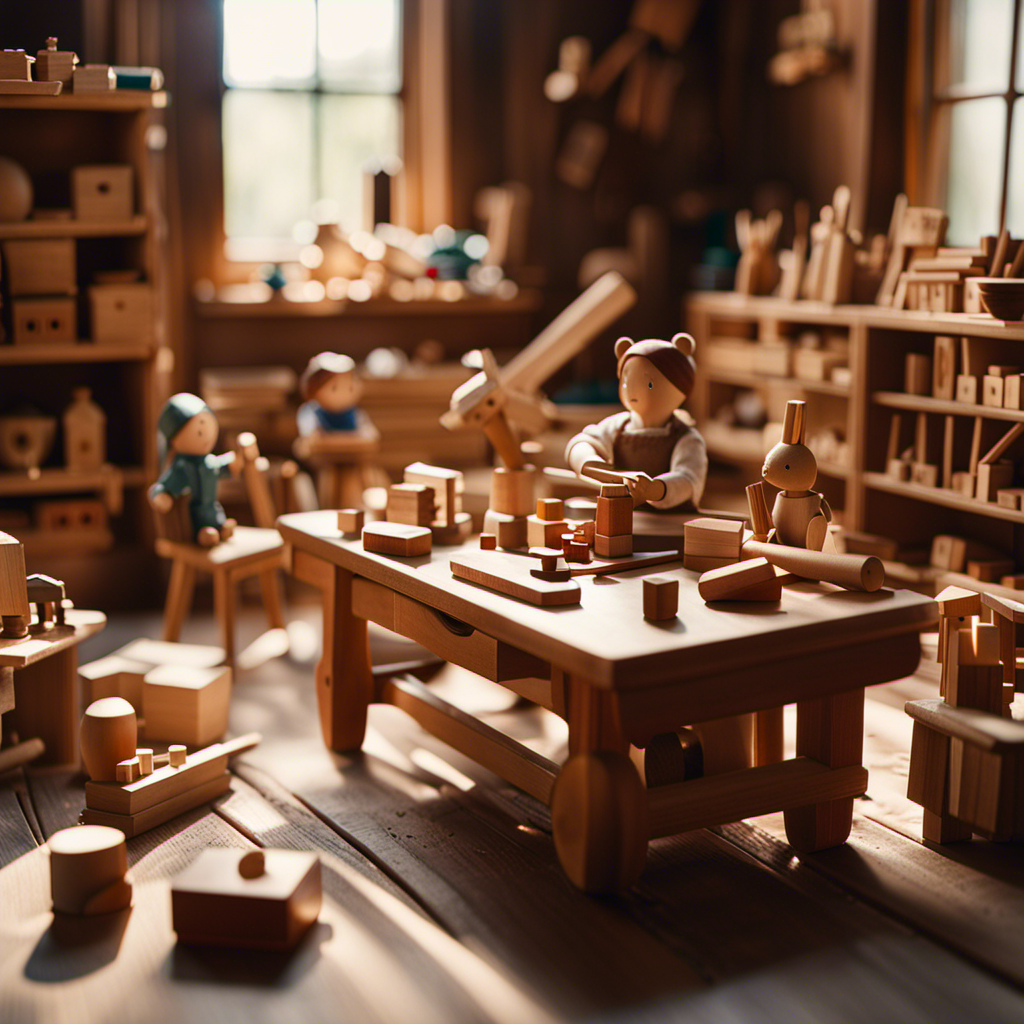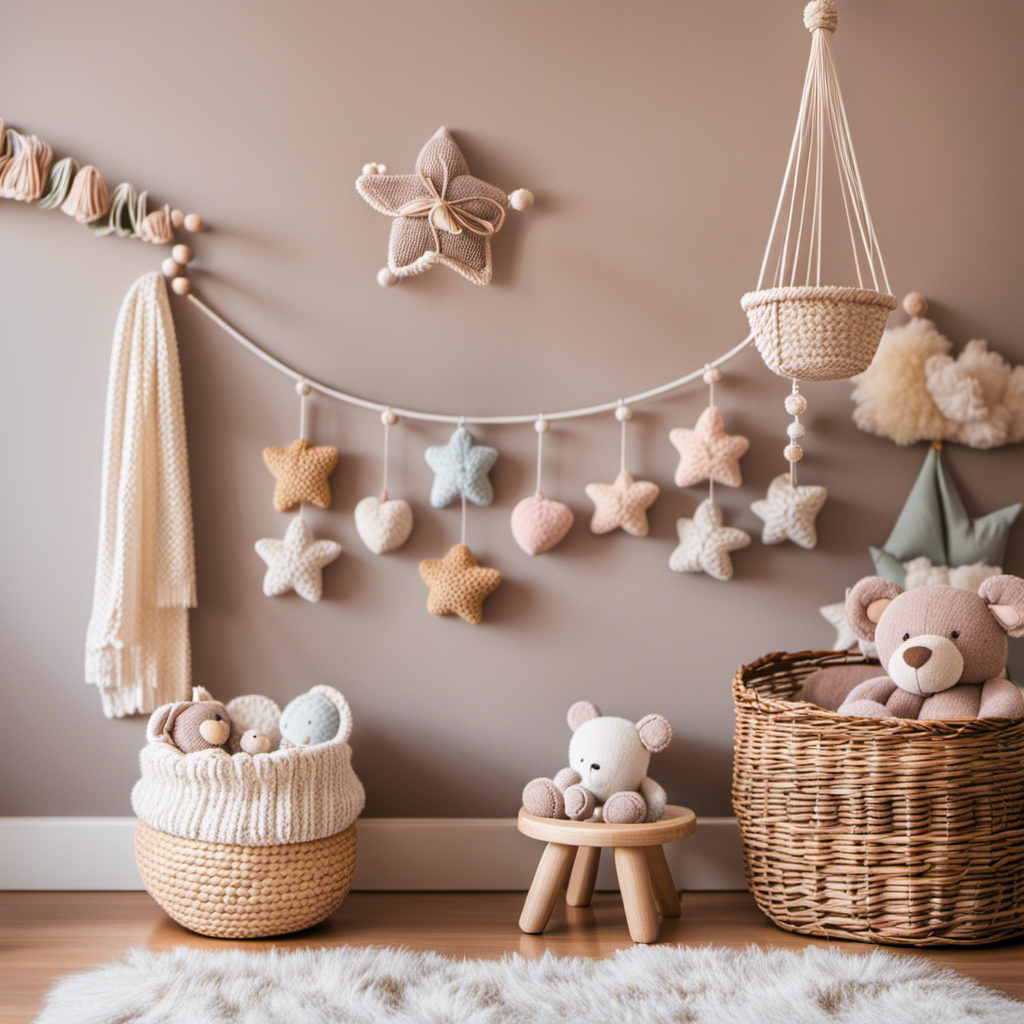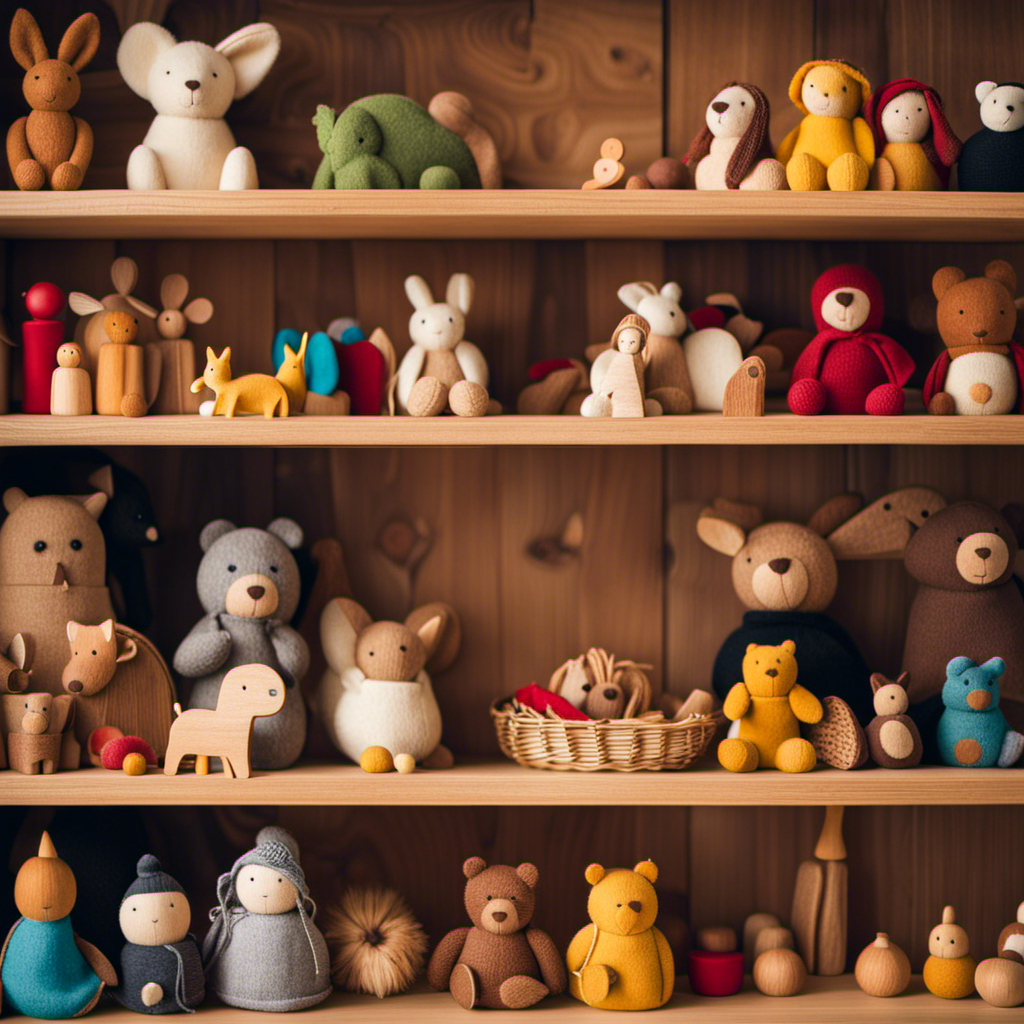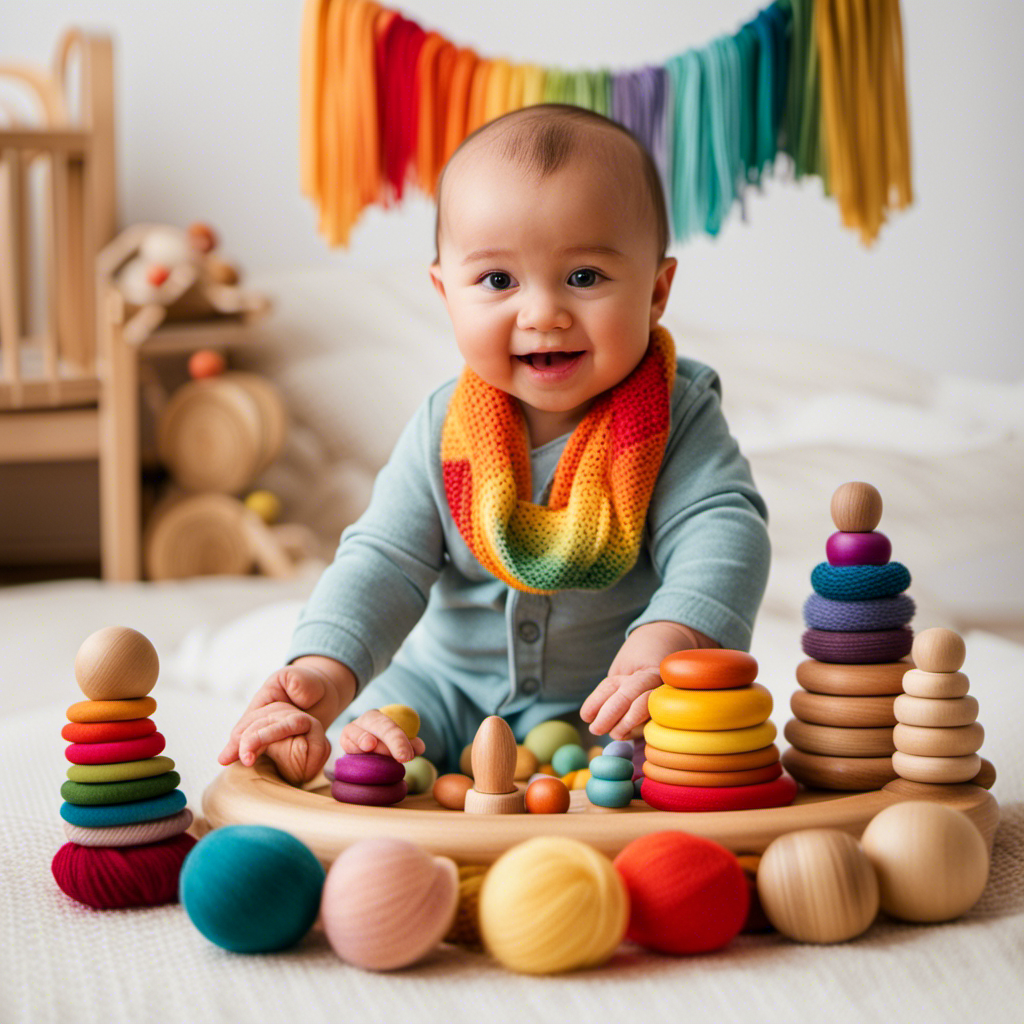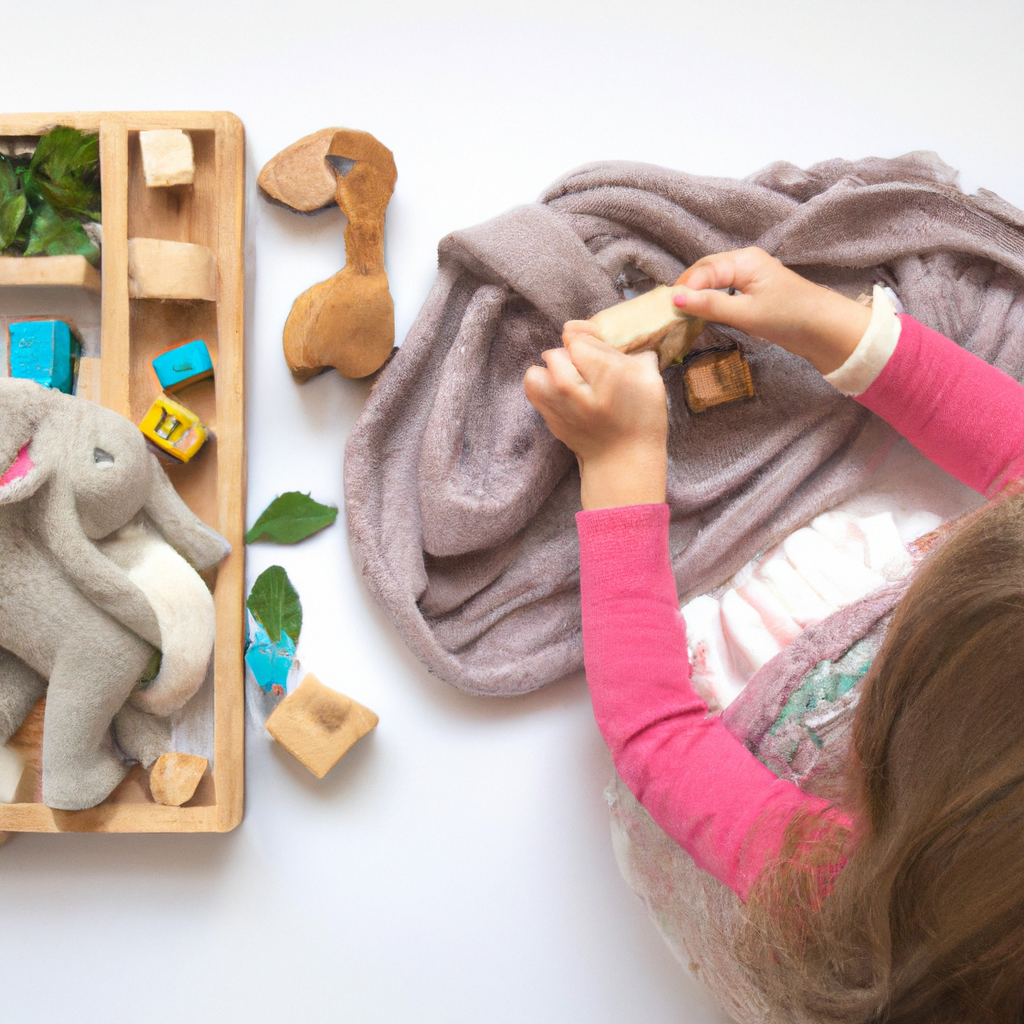Steiner’s impact endures in the world of children’s play, much like a comforting sunbeam that breaks through the chill of a new day.
As an advocate of Waldorf education, I have witnessed firsthand the transformative power of Waldorf wooden toys.
In this article, we will explore the origins of Waldorf education, delve into the visionary mind of Rudolf Steiner, and uncover the multitude of benefits these timeless toys offer in fostering imagination, creativity, and a deep connection to nature.
Join me on this journey as we celebrate the simplicity and lasting appeal of Waldorf wooden toys in the digital age.
Key Takeaways
- Waldorf Education was founded by Rudolf Steiner, an Austrian philosopher and educator who believed in holistic development.
- Waldorf Wooden Toys provide sensory stimulation, enhance fine motor skills, and encourage creativity and imaginative play scenarios.
- Sensory play with wooden toys enhances spatial awareness, hand-eye coordination, and problem-solving skills.
- Waldorf Wooden Toys are environmentally friendly, made from sustainable materials, and promote a holistic approach to a child’s growth.
The Origins of Waldorf Education
If you’re interested in the origins of Waldorf Education, you’ll be fascinated to learn about its roots in the early 20th century.
The origins of Waldorf Education can be traced back to Rudolf Steiner, an Austrian philosopher and educator. Steiner believed that education should focus on the holistic development of the child, incorporating intellectual, artistic, and practical skills. His ideas were influenced by various educational philosophies of the time, including the ideas of Friedrich Froebel and Maria Montessori.
Steiner’s vision for education emphasized the importance of creativity, imagination, and hands-on learning. This approach became known as Waldorf Education, named after the first school in Stuttgart, Germany, which opened in 1919.
Steiner’s influence on Waldorf Education can still be seen today, as his principles continue to shape the curriculum and teaching methods used in Waldorf schools worldwide.
As we delve into the legacy of Waldorf wooden toys, it is essential to understand the profound influence of Rudolf Steiner on this unique educational approach.
Rudolf Steiner: The Visionary Behind Waldorf Wooden Toys
Learn about the visionary behind these timeless toys and discover the influence of Rudolf Steiner.
Rudolf Steiner, an Austrian philosopher, educator, and founder of the Waldorf education system, had a significant impact on early childhood education. His approach emphasized the importance of holistic development, nurturing the child’s physical, emotional, and spiritual well-being.
Steiner believed that children learn best through imaginative play and hands-on experiences, which led to the creation of Waldorf wooden toys. These toys are carefully crafted from natural materials, such as wood, and are designed to stimulate the child’s senses and encourage creativity.
Steiner’s philosophy of education has had a profound influence on modern teaching methods, promoting a child-centered approach that values imagination, creativity, and the development of the whole child.
As we delve into the benefits of wooden toys in early childhood development, we will see how Steiner’s vision continues to shape educational practices today.
The Benefits of Wooden Toys in Early Childhood Development
When it comes to early childhood development, wooden toys offer a multitude of benefits.
Firstly, they provide sensory stimulation, allowing children to explore different textures, shapes, and weights. This not only enhances their fine motor skills but also promotes cognitive development.
Secondly, wooden toys encourage creativity and imagination, as they can be used in various imaginative play scenarios.
Lastly, opting for wooden toys is an environmentally friendly choice, as they are made from sustainable materials and do not contribute to plastic waste.
Sensory Stimulation Benefits
The use of Waldorf wooden toys provides children with a range of sensory stimulation benefits. Sensory play is crucial for a child’s development as it helps them explore their surroundings and learn about the world through their senses. Tactile experiences, in particular, play a vital role in enhancing a child’s cognitive and physical development. When children engage with Waldorf wooden toys, they are exposed to a variety of textures, shapes, and weights, stimulating their sense of touch. This tactile exploration not only improves their fine motor skills but also enhances their spatial awareness and hand-eye coordination. To illustrate the benefits of sensory play, consider the following table:
Sensory Stimulation Benefits of Waldorf Wooden Toys:
| Benefits | Description |
|---|---|
| Enhances fine motor skills | Manipulating wooden toys helps develop finger dexterity and hand strength. |
| Improves spatial awareness | Exploring different shapes and sizes promotes understanding of spatial relationships. |
| Develops hand-eye coordination | Coordinating hand movements with visual stimuli improves motor skills. |
| Stimulates creativity and imagination | Open-ended play with wooden toys encourages imaginative thinking and problem-solving. |
Creativity and Imagination Boost
To boost your child’s creativity and imagination, encourage them to engage in open-ended play with these toys. Open-ended play refers to play that has no specific rules or instructions, allowing children to use their imagination and creativity to explore and create their own narratives and scenarios.
Toys that facilitate open-ended play, such as building blocks, dress-up costumes, and art supplies, provide endless possibilities for imaginative play. Children can build, pretend, and invent, creating their own stories and worlds. This type of play not only stimulates their creativity and imagination but also enhances their problem-solving skills, social skills, and cognitive development.
By engaging in open-ended play, children are able to express their thoughts and ideas, develop their own unique play styles, and unleash their limitless potential.
Moving on to the environmentally friendly option…
Environmentally Friendly Option
By choosing eco-friendly toys, parents can provide their children with a sustainable and safe play experience. Sustainability and eco consciousness are becoming increasingly important in today’s world, and this extends to the toys we choose for our children. Here are four reasons why eco-friendly toys are a great option for parents:
-
Environmental Impact: Eco-friendly toys are made from sustainable materials, such as wood, organic cotton, or recycled plastic. By opting for these toys, we can reduce our carbon footprint and minimize the impact on the environment.
-
Health and Safety: Many conventional toys contain harmful chemicals and toxins that can be harmful to children. Eco-friendly toys, on the other hand, are made from natural and non-toxic materials, ensuring a safe and healthy play experience.
-
Longevity: Eco-friendly toys are often made to last. They are durable and can withstand the test of time, reducing the need for frequent replacements and ultimately reducing waste.
-
Educational Value: Many eco-friendly toys are designed to promote learning and development. They encourage creativity, problem-solving, and imaginative play, fostering a holistic approach to a child’s growth.
The Timeless Appeal of Waldorf Wooden Toys
Immerse yourself in the timeless appeal of Waldorf wooden toys. These toys have gained popularity for their sustainable play and use of natural materials.
Waldorf wooden toys are crafted from non-toxic, eco-friendly materials like organic wood, allowing children to engage in safe and environmentally conscious play. The simplicity and beauty of these toys captivate children and adults alike.
The smooth texture and warm colors of the wood invite tactile exploration and sensory stimulation. The lack of batteries or flashing lights encourages children to use their imagination and creativity to bring the toys to life.
Waldorf wooden toys provide a platform for open-ended play, allowing children to explore different scenarios and develop problem-solving skills.
Now, let’s delve into how Waldorf wooden toys foster imagination and creativity.
How Waldorf Wooden Toys Foster Imagination and Creativity
Open-ended play possibilities and nurturing imaginative play are key aspects of how Waldorf wooden toys foster imagination and creativity.
By providing toys that do not have a specific purpose or predetermined outcome, children are encouraged to explore and create their own narratives and scenarios.
This type of play allows for endless possibilities and encourages children to use their imagination and problem-solving skills.
Additionally, the simplicity and natural materials of Waldorf wooden toys help to stimulate the senses and provide a more tactile and immersive play experience, further enhancing the development of imaginative play.
Open-Ended Play Possibilities
There’s no limit to the creative possibilities when children engage in open-ended play with Waldorf wooden toys. Open-ended play refers to activities that have no predetermined outcome, allowing children to freely explore and create using their imagination.
This type of play has numerous benefits for children’s development. Firstly, it fosters imagination, as children are encouraged to invent their own stories, characters, and scenarios. Through open-ended play, children learn to think creatively and problem-solve, as they navigate through different situations with their toys.
It also promotes social skills, as children often engage in collaborative play, negotiating roles and sharing ideas with their peers. By nurturing their imagination and creativity, open-ended play with Waldorf wooden toys lays a solid foundation for a lifetime of imaginative exploration and learning.
Nurturing Imaginative Play
You can foster imagination and creativity in your child by encouraging them to engage in play that allows for endless possibilities and free exploration. Here are some ways to nurture imaginative play:
-
Provide open-ended toys: Toys that don’t have a set purpose or predetermined outcome can spark your child’s imagination. Waldorf wooden toys, with their simple designs and natural materials, are perfect for this.
-
Encourage nature-inspired play: Take your child outside to explore the natural world. They can collect leaves, pinecones, and rocks to use in their imaginative play. This connection to nature can inspire creativity and a sense of wonder.
-
Embrace the role of storytelling: Storytelling can transport your child to different worlds and ignite their imagination. Encourage them to create their own stories, whether it’s through pretend play or writing and illustrating their own books.
By incorporating these elements into playtime, you can cultivate your child’s imagination and creativity.
Now, let’s transition into exploring the natural materials used in Waldorf wooden toys without missing a beat.
Exploring the Natural Materials Used in Waldorf Wooden Toys
Take a moment to appreciate the natural materials that are used in Waldorf wooden toys. These toys are not only beautifully crafted, but they also promote sustainability and encourage natural play. The use of wood as a primary material reflects the Waldorf philosophy of connecting children with nature and fostering a sense of environmental stewardship. The smooth texture and warm hues of the wood create a sensory experience that is both calming and engaging for young children. Moreover, the durability of wooden toys ensures their longevity, reducing the need for frequent replacements and minimizing waste. In a world dominated by plastic toys, Waldorf wooden toys offer a refreshing alternative that is not only aesthetically pleasing but also environmentally conscious.
| Advantages of Waldorf Wooden Toys | |
|---|---|
| Sustainable | Promotes natural play |
| Eco-friendly | Durable and long-lasting |
| Non-toxic | Enhances sensory experience |
The natural materials used in Waldorf wooden toys embody the principles of Rudolf Steiner’s educational philosophy. These toys play a vital role in fostering a connection between children and the natural world, encouraging imaginative play and stimulating the senses.
The Role of Waldorf Wooden Toys in Steiner’s Educational Philosophy
As an educator and advocate for play-based learning, I’ve come to appreciate the many educational benefits of Waldorf wooden toys.
These toys not only engage children in imaginative play but also promote the development of essential skills such as fine motor skills, problem-solving abilities, and creativity.
Furthermore, there’s a strong connection between play and learning. Play allows children to explore and make sense of the world around them in a hands-on and meaningful way.
Educational Benefits of Waldorf Wooden Toys
Explore the educational benefits of Waldorf wooden toys and discover how they can enhance your child’s learning experience. These toys are designed to stimulate sensory development and promote the development of fine motor skills.
Here are three specific ways in which Waldorf wooden toys can benefit your child’s education:
-
Sensory Stimulation: The natural textures and materials used in Waldorf wooden toys engage multiple senses, allowing children to explore different textures, shapes, and weights. This sensory stimulation enhances their cognitive development and helps them make connections between their senses and the world around them.
-
Fine Motor Skills Development: Manipulating the different components of Waldorf wooden toys, such as stacking blocks or fitting puzzle pieces together, requires precise hand-eye coordination and dexterity. This hands-on play promotes the development of fine motor skills, which are essential for tasks such as writing, drawing, and tying shoelaces.
-
Open-Ended Play: Waldorf wooden toys are intentionally designed to be open-ended, allowing children to use their imagination and creativity. This type of play encourages problem-solving, critical thinking, and the exploration of different possibilities.
Connection Between Play and Learning
In the previous section, we explored the educational benefits of Waldorf wooden toys. Now, let’s delve into the connection between play and learning, and how it relates to the enduring charm of these toys.
Play-based learning is a fundamental aspect of the Waldorf education philosophy. It recognizes that children learn best when they are engaged in imaginative and creative play. Through play, children develop essential skills such as problem-solving, social interaction, and critical thinking.
Imagination plays a crucial role in learning as it allows children to explore and make sense of the world around them. When children engage with Waldorf wooden toys, they are encouraged to use their imagination to create stories, scenarios, and characters. This imaginative play sparks their curiosity, fosters creativity, and enhances their cognitive development.
To further illustrate the connection between play and learning, take a look at the table below:
| Play-based Learning Benefits | Role of Imagination in Learning |
|---|---|
| Enhances problem-solving skills | Sparks curiosity and creativity |
| Develops social interaction skills | Fosters cognitive development |
| Encourages critical thinking | Stimulates imaginative play |
Understanding the importance of play-based learning and the role of imagination in learning helps us appreciate why Waldorf wooden toys continue to captivate children and adults alike.
Now, let’s move on to the subsequent section, where we will explore how Waldorf wooden toys are a sustainable and eco-friendly choice.
Waldorf Wooden Toys: A Sustainable and Eco-Friendly Choice
You’ll love how Waldorf wooden toys are a sustainable and eco-friendly choice for playtime. Here are four reasons why:
-
Renewable Materials: Waldorf wooden toys are made from sustainably sourced wood, such as maple or beech. These materials are renewable, meaning they can be replenished over time, making them a more environmentally friendly option.
-
Non-Toxic and Safe: Unlike plastic toys that can contain harmful chemicals, Waldorf wooden toys are often finished with natural oils or beeswax, making them safe for children to play with. These toys are also durable and resistant to breakage, reducing the need for replacements.
-
Longevity: Wooden toys are known for their durability, allowing them to be passed down through generations. This not only reduces waste but also encourages a more mindful and conscious approach to consumption.
-
Minimalist Design: Waldorf wooden toys have a simple and minimalist design, encouraging open-ended play and sparking children’s imagination. This promotes a more sustainable and eco-conscious mindset, as children learn to appreciate the beauty and simplicity of natural materials.
Nurturing a Connection to Nature With Waldorf Wooden Toys
Immerse yourself in the natural world with the help of these sustainable and imaginative playthings.
Nature inspired play is at the heart of Waldorf education, which emphasizes the importance of connecting children with the outdoors.
Waldorf wooden toys are designed to bring the beauty and wonder of nature into a child’s play experience. From simple wooden blocks that can be stacked and built into various structures, to wooden animals that encourage imaginative storytelling, these toys provide endless possibilities for creative play.
By incorporating elements from the natural world, such as tree branches, leaves, and rocks, Waldorf wooden toys foster a deep appreciation for nature and encourage children to explore and engage with their environment.
The durability and longevity of these toys further underscore their commitment to sustainability, ensuring that they can be enjoyed by generations to come.
The Durability and Longevity of Waldorf Wooden Toys
When caring for your child’s toys, it’s important to note the durability and longevity of Waldorf wooden toys. These toys are designed to withstand years of play and still maintain their charm and functionality.
The use of high-quality materials such as solid wood and non-toxic paints ensures that these toys can withstand the test of time. Not only are they durable, but they are also sustainable, as they are made from renewable resources and are biodegradable.
The benefits of Waldorf wooden toys go beyond their durability and sustainability. They also promote the development of fine motor skills and hand-eye coordination. The natural textures and simple designs of these toys allow children to engage in open-ended play, fostering creativity and imagination.
With their enduring charm, Waldorf wooden toys can be cherished heirlooms that can be passed down through generations, preserving Steiner’s legacy.
Waldorf Wooden Toys as Heirlooms: Passing Down the Legacy
As we discussed earlier, Waldorf wooden toys are known for their durability and longevity. But they are more than just toys; they hold a deeper significance as family heirlooms. The beauty and craftsmanship of these toys make them perfect for passing down traditions from one generation to another.
I remember playing with the same wooden dollhouse that was once my mother’s, and now it brings joy to my own children. These toys create a sense of connection and continuity, reminding us of our shared history and values. They become cherished objects that carry the stories and memories of our family.
In a world dominated by technology and fast-paced consumerism, embracing the simplicity and timelessness of Waldorf wooden toys allows us to preserve our heritage and create lasting bonds with our loved ones.
And now, let’s delve into the concept of embracing simplicity: Waldorf wooden toys in the digital age.
Embracing Simplicity: Waldorf Wooden Toys in the Digital Age
You can find comfort in the simplicity of Waldorf toys even in the digital age, as they offer a refreshing break from the constant stimulation of screens and electronics. In a world where children are constantly bombarded with flashy gadgets and virtual experiences, Waldorf wooden toys provide a much-needed digital detox. These toys are designed to engage children in open-ended play, allowing them to use their imagination and creativity. The role of play in a child’s development cannot be underestimated. It helps them develop important skills such as problem-solving, social interaction, and emotional regulation. Waldorf toys, with their natural materials and minimalist design, encourage children to explore the world around them in a tactile and hands-on way. They promote a sense of calm and tranquility, providing a welcome respite from the fast-paced, technology-driven world we live in.
| Waldorf Wooden Toys | Benefits |
|---|---|
| Natural materials | Promotes sensory development and connection to nature |
| Minimalist design | Encourages imagination and creativity |
| Open-ended play | Develops problem-solving skills |
| Tactile and hands-on | Enhances fine motor skills and coordination |
The digital age has its merits, but it’s important to balance technology with real-world experiences. Waldorf wooden toys offer a much-needed antidote to the constant stimulation of screens, allowing children to engage in meaningful and imaginative play. In a world that seems to be moving at an increasingly fast pace, these toys provide a sense of simplicity and calmness that is often lacking in our digital lives. So, embrace the simplicity of Waldorf toys and give your child the gift of a digital detox and the opportunity to truly play and explore the world around them.
Frequently Asked Questions
What Are Some Popular Alternatives to Waldorf Wooden Toys?
There are several popular alternatives to Waldorf wooden toys. Some sustainable toy options include natural materials like bamboo and organic cotton. These toys offer the benefits of open-ended play, fostering creativity and imagination.
Are Waldorf Wooden Toys Suitable for Children of All Ages?
Yes, Waldorf wooden toys are suitable for children of all ages. They offer numerous benefits in early childhood education, fostering creativity and imagination. They provide a tactile and open-ended play experience that encourages exploration and problem-solving skills.
How Do Waldorf Wooden Toys Support Cognitive Development?
Waldorf wooden toys promote cognitive development by encouraging open-ended play. They benefit children of all ages by fostering imagination, creativity, problem-solving skills, and critical thinking. Through hands-on exploration, children can learn and grow in a holistic and meaningful way.
Can Waldorf Wooden Toys Be Personalized or Customized?
Yes, Waldorf wooden toys can be personalized or customized to meet individual preferences. This allows for a unique and tailored play experience, enhancing creativity and imagination while fostering a deeper connection with the toy.
Where Can I Purchase Waldorf Wooden Toys?
I love purchasing Waldorf wooden toys because they offer numerous benefits for child development. They encourage open-ended play, sparking creativity and imagination. One can find these toys at specialty toy stores, online marketplaces, and even local craft fairs.
Conclusion
In conclusion, the enduring charm of Waldorf wooden toys is a testament to Rudolf Steiner’s visionary approach to education. These toys not only provide countless benefits for early childhood development, but they also foster imagination, creativity, and a deep connection to nature.
With their durability and longevity, Waldorf wooden toys can be cherished for generations, becoming cherished heirlooms. In a world consumed by technology, embracing the simplicity and timeless appeal of these toys is a powerful way to foster a child’s growth and development.
So, let us continue to embrace the legacy of Steiner and the enduring charm of Waldorf wooden toys.
Avery brings the magic of words to life at Toddler Ride On Toys. As a dedicated writer, she combines her love for writing with her fascination for child development to craft articles that resonate with our audience. With a background in journalism and a knack for storytelling, Avery’s pieces inform, engage, and inspire parents and caregivers.
